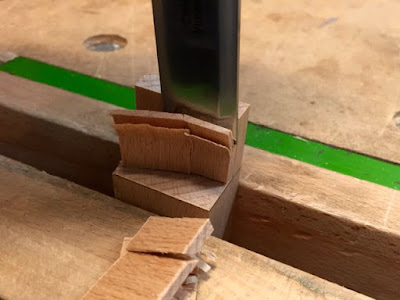Whenever it comes to fix a table top to a table frame, turn buttons are my choice.
Let me show you how I usually make mine.
It all starts with a piece of wood from my scrap box, or if I can't find a fitting piece I've got some stock for such purposes.
 |
| Stock from the scrap box |
The piece was long enough to get 4 turn buttons out of it. I only need three, so I will have one as spare part.
 |
| Define a length |
The stock had already one end square so I could start from that end. I came in about 8 cm and made a pencil mark.
 |
| V groove for sawing |
I made a knife line and a little groove for registering my saw.
 |
| Cutting to length |
And then I tried to cut down as square as possible. I use such tasks all the time as a training opportunity. Making turn buttons is not exact science. No need to be pretty precise. As mentioned, use it as a training opportunity.
 |
| Slightly off |
I'm slightly off. I will shoot it anyway. Just to see how good or bad I am.
 |
| Make marks from both ends |
Now then. That piece cut and shot, I came in 3 cm from each end.
 |
| The basic layout |
Next step was to draw a line all around the piece at both marks. I'm slightly off again. That's because of the new magic pencils. I have to adjust them better ;-)
 |
| Scribe a line.... |
Now make a scribe line between the two pencil marks. The distance depends on the thickness of your stock. In my case the material thickness is 3 cm and I wanted to have 8 mm thick tongues. So I came in 2 cm.
 |
| ....and a second one |
Flip the piece around and do the same thing from the other side.
 |
| Make a knife line around |
When you have done your scribe lines start to make a marking line around the piece. Starting from the lower scribe line and ending there on the other side of the piece.
Do this action from the opposite side again.
 |
| You have to mark it from both opposite faces |
You will end with something like this.
 |
| Saw down from every face |
Now saw down to the lower scribe line. Once from each face side.
 |
| Position it on an edge |
Done!? It should look like in the picture above. If it looks like that, then position your piece on the edge of your bench hook for example.
 |
| Don't hesitate :-) |
And now, give it an encouraged whack with your hammer. You will see that it will split apart.
 |
| Freshly splitted |
It will come out somehow like this.
 |
| Split the rest away |
Split the rest of the material away with a chisel.
 |
| Turn button blanks |
Nearly done. This are the turn button blanks.
 |
| Make a cross like this and mark the middle with an awl |
Make a cross like you can see in the picture and pre drill a small hole with an awl.
 |
| Grabb you hand drill |
Grabb a drill and bore a hole. An important point. This hole has to be big enough so that your screw won't bite into it. They shall just slide through it.
 |
| Countersink the hole |
Countersink the hole.
 |
| Test fit |
And here we are. The new turn buttons.
 |
| Ready |
One last thing. Remove the marks. I've done two strokes with a #4.
They are pretty easy to make and provide a nice possibility to mount a table top.
Hope you like that write up. Let me know what you think about it.



Nifty, never seen done that way. The hammer wack sound like a fun thing to do :-)
ReplyDeleteBob and Rudy, having family visit this week
Perfect! I'll be making some today to mount a japanese screen onto the wall. I coundn't find anything which would do the screen justice. I'll ebonise mine to go with the lacquer. Thank you
ReplyDelete